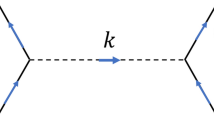Abstract
The convergence for the Imaginary Time Step (ITS) evolution with time step is investigated by performing the ITS evolution for the Schrödinger-like equation and the charge-conjugate Schrödinger-like equation deduced from Dirac equation for the single proton levels of 12C in both the Fermi and Dirac seas. For the guaranteed convergence of the ITS evolution to the “exact” results, the time step should be smaller than a “critical” time step Δt c for a given single-particle level. The “critical” time step Δt c is more sensitive to the quantum numbers |κ| than to the energy of the single-particle level. For the single-particle levels with the same κ, their “critical” time steps are in the same order. For the single-particle levels with similar energy, a relatively small (large) “critical” time step for larger (smaller) |κ| is needed. These conclusions can be used in the future self-consistent calculation to optimize the evolution procedure.
Similar content being viewed by others
References
Tanihata I, Hamagaki H, Hashimoto O, et al. Measurements of interaction cross sections and nuclear radii in the light p-shell region. Phys Rev Lett, 1985, 55: 2676–2679
Bertulani C A, Hussein M S, Münzengerg G. Physics of Radioactive Beams. New York: Nova Science Publishers, Inc, 2001
Jonson B. Light dripline nuclei. Phys Rep, 2004, 389: 1–59
Jensen A S, Riisager K, Fedorov D V, et al. Structure and reactions of quantum halos. Rev Mod Phys, 2004, 76: 215–261
Xu H S, Tu X L, Yuan Y J, et al. First mass measurement of short-lived nuclides at HIRFL-CSR. Chinese Sci Bull, 2009, 54: 4749–4752
Sun Y. Nuclear masses near the proton drip-line and their impact on nucleosynthesis in explosive stars. Chinese Sci Bull, 2009, 54: 4594–4595
Serot B D, Walecka J D. The relativistic nuclear many-body problem. Adv Nucl Phys, 1986, 16: 1–327
Ring P. Relativistic mean field theory in finite nuclei. Prog Part Nucl Phys, 1996, 37: 193–263
Vretenar D, Afanasjev A V, Lalazissis G A, et al. Relativistic Hartree-Bogoliubov theory: Static and dynamic aspects of exotic nuclear structure. Phys Rep, 2005, 40: 101–259
Meng J, Toki H, Zhou S G, et al. Relativisitc continuum Hartree Bogoliubov theory for ground-state properties of exotic nuclei. Prog Part Nucl Phys, 2006, 57: 470–563
Li J, Zhang Y, Yao J M, et al. Magnetic moments of 33Mg in the timeodd relativistic mean field approach. Sci China Ser G-PhysMech Astron, 2009, 52: 1586–1592
Meng J, Ring P. Relativistic Hartree-Bogoliubov description of the neutron halo in 11Li. Phys Rev Lett, 1996, 77: 3963–3966
Meng J, Tanihata I. Yamaji S. The proton and neutron distributions in Na isotopes: The development of halo and shell structure. Phys Lett B, 1998, 419: 1–6
Meng J, Ring P. Giant halo at the neutron drip line. Phys Rev Lett, 1998, 80: 460–463
Price C E, Walker G E. Self-consistent Hartree description of deformed nuclei in a relativistic quantum field theory. Phys Rev C, 1987, 36: 354–364
Meng J, Lü H F, Zhang S Q, et al. Giant, hyperon, and deformed halos near the particle drip line. Nucl Phys A, 2003, 722: 366c–371c
Zhou S G, Meng J, Ring P. Spherical relativistic Hartree theory in a Woods-Saxon basis. Phys Rev C, 2003, 68: 034323
Davies K T R, Flocard H, Krieger S, et al. Application of the imaginary time step method to the solution of the static Hartree-Fock problem. Nucl Phys A, 1980, 342: 111–123
Zhang Y, Liang H Z, Meng J. Avoid the Tsunami of the Dirac sea in the imaginary time step method. arXiv, 0905.2505v1 [nucl-th]
Zhang Y, Liang H Z, Meng J. Solving the Dirac equation with Nonlocal potential by imaginary time step method. Chin Phys Lett, 2009, 26: 092401
Bonche P, Flocard H, Heenen P H. Solution of the Skyrme HF + BCS equation on a 3D mesh. Comput Phys Commun, 2005, 171: 49–62
Zhang H, Lu W T, Wang S J. Algebraic dynamics solution and algebraic dynamics algorithm of Burgers equations. Sci China Ser G-Phys Mech Astron, 2008, 51: 1647–1652
Author information
Authors and Affiliations
Corresponding author
Additional information
Recommended by LONG GuiLu
Rights and permissions
About this article
Cite this article
Li, F., Zhang, Y. & Meng, J. Convergence for Imaginary Time Step evolution in the Fermi and Dirac seas. Sci. China Phys. Mech. Astron. 53, 327–330 (2010). https://doi.org/10.1007/s11433-010-0121-2
Received:
Accepted:
Published:
Issue Date:
DOI: https://doi.org/10.1007/s11433-010-0121-2



